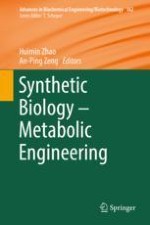2018 | OriginalPaper | Buchkapitel
Engineering and Evolution of Saccharomyces cerevisiae to Produce Biofuels and Chemicals
verfasst von : Timothy L. Turner, Heejin Kim, In Iok Kong, Jing-Jing Liu, Guo-Chang Zhang, Yong-Su Jin
Erschienen in: Synthetic Biology – Metabolic Engineering
Aktivieren Sie unsere intelligente Suche, um passende Fachinhalte oder Patente zu finden.
Wählen Sie Textabschnitte aus um mit Künstlicher Intelligenz passenden Patente zu finden. powered by
Markieren Sie Textabschnitte, um KI-gestützt weitere passende Inhalte zu finden. powered by
